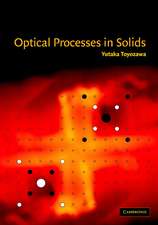The Glass Transition: Relaxation Dynamics in Liquids and Disordered Materials: Springer Series in Materials Science, cartea 48
Autor E. Donthen Limba Engleză Hardback – 6 iun 2001
| Toate formatele și edițiile | Preț | Express |
|---|---|---|
| Paperback (1) | 945.88 lei 6-8 săpt. | |
| Springer Berlin, Heidelberg – dec 2010 | 945.88 lei 6-8 săpt. | |
| Hardback (1) | 951.11 lei 6-8 săpt. | |
| Springer Berlin, Heidelberg – 6 iun 2001 | 951.11 lei 6-8 săpt. |
Din seria Springer Series in Materials Science
- 18%
 Preț: 1820.22 lei
Preț: 1820.22 lei - 18%
 Preț: 776.09 lei
Preț: 776.09 lei - 24%
 Preț: 689.68 lei
Preț: 689.68 lei - 18%
 Preț: 968.96 lei
Preț: 968.96 lei - 20%
 Preț: 568.94 lei
Preț: 568.94 lei - 18%
 Preț: 953.65 lei
Preț: 953.65 lei - 18%
 Preț: 902.36 lei
Preț: 902.36 lei - 18%
 Preț: 953.65 lei
Preț: 953.65 lei - 20%
 Preț: 948.41 lei
Preț: 948.41 lei - 18%
 Preț: 1143.07 lei
Preț: 1143.07 lei - 18%
 Preț: 1111.53 lei
Preț: 1111.53 lei - 18%
 Preț: 1103.62 lei
Preț: 1103.62 lei - 18%
 Preț: 1225.94 lei
Preț: 1225.94 lei -
 Preț: 473.91 lei
Preț: 473.91 lei - 18%
 Preț: 782.42 lei
Preț: 782.42 lei -
 Preț: 433.47 lei
Preț: 433.47 lei - 18%
 Preț: 1116.40 lei
Preț: 1116.40 lei - 18%
 Preț: 946.24 lei
Preț: 946.24 lei - 18%
 Preț: 945.20 lei
Preț: 945.20 lei - 15%
 Preț: 641.20 lei
Preț: 641.20 lei - 18%
 Preț: 958.56 lei
Preț: 958.56 lei - 18%
 Preț: 1224.36 lei
Preț: 1224.36 lei - 15%
 Preț: 644.82 lei
Preț: 644.82 lei - 24%
 Preț: 833.43 lei
Preț: 833.43 lei - 24%
 Preț: 1060.33 lei
Preț: 1060.33 lei - 18%
 Preț: 964.10 lei
Preț: 964.10 lei - 18%
 Preț: 1224.36 lei
Preț: 1224.36 lei - 18%
 Preț: 1221.20 lei
Preț: 1221.20 lei - 18%
 Preț: 946.87 lei
Preț: 946.87 lei - 18%
 Preț: 1836.92 lei
Preț: 1836.92 lei - 15%
 Preț: 643.34 lei
Preț: 643.34 lei - 18%
 Preț: 1246.32 lei
Preț: 1246.32 lei - 18%
 Preț: 956.81 lei
Preț: 956.81 lei - 18%
 Preț: 953.52 lei
Preț: 953.52 lei - 15%
 Preț: 637.59 lei
Preț: 637.59 lei - 24%
 Preț: 1060.87 lei
Preț: 1060.87 lei
Preț: 951.11 lei
Preț vechi: 1159.89 lei
-18% Nou
Puncte Express: 1427
Preț estimativ în valută:
181.99€ • 190.01$ • 150.62£
181.99€ • 190.01$ • 150.62£
Carte tipărită la comandă
Livrare economică 04-18 aprilie
Preluare comenzi: 021 569.72.76
Specificații
ISBN-13: 9783540418016
ISBN-10: 3540418016
Pagini: 444
Ilustrații: XVII, 418 p.
Dimensiuni: 155 x 235 x 29 mm
Greutate: 0.76 kg
Ediția:2001
Editura: Springer Berlin, Heidelberg
Colecția Springer
Seria Springer Series in Materials Science
Locul publicării:Berlin, Heidelberg, Germany
ISBN-10: 3540418016
Pagini: 444
Ilustrații: XVII, 418 p.
Dimensiuni: 155 x 235 x 29 mm
Greutate: 0.76 kg
Ediția:2001
Editura: Springer Berlin, Heidelberg
Colecția Springer
Seria Springer Series in Materials Science
Locul publicării:Berlin, Heidelberg, Germany
Public țintă
ResearchCuprins
1. Introduction.- 2. Description of the Phenomenon.- 3. Theoretical Framework.- 4. Slowing Down Mechanisms.- 5. Epilogue.- 6. Conclusion.- A. Synonyms.- B. List of New Concepts.- C. Acronyms.- References.
Recenzii
From the reviews of the first edition:
"A welcome addition to the literature on a subject that is currently attracting a very heavy research interest… the author means the entire process of viscous slowdown and vitrification... he may well be the best-read author in this field. I found information that was new and interesting to me in nearly every section. There seems to be no element of the subject on which Donth has not read widely and deeply. [His] use of figures, backed up by appropriate text, can be an effective way of conveying a lot of information about (and insight into) the system behavior… This book is an excellent choice of reading material for someone newly entering the field, who wants to be made aware of its elements. It also provides much food for thought for the experts." PHYSICS TODAY (Dec. 2002)
"The glass transition is one of the most challenging tasks waiting for its explanation and understanding. … This excellent book is simply a must not only for scientists working in the glass transition, but also important for material scientists, engineers. Its concept also makes the book to stand as a textbook for advanced or postgraduate students. Extensive referencing, general scope of the book … make the book readable as a bestseller." (Ondrej Gedeon, Ceramics, Vol. 46 (1), 2002)
"A welcome addition to the literature on a subject that is currently attracting a very heavy research interest… the author means the entire process of viscous slowdown and vitrification... he may well be the best-read author in this field. I found information that was new and interesting to me in nearly every section. There seems to be no element of the subject on which Donth has not read widely and deeply. [His] use of figures, backed up by appropriate text, can be an effective way of conveying a lot of information about (and insight into) the system behavior… This book is an excellent choice of reading material for someone newly entering the field, who wants to be made aware of its elements. It also provides much food for thought for the experts." PHYSICS TODAY (Dec. 2002)
"The glass transition is one of the most challenging tasks waiting for its explanation and understanding. … This excellent book is simply a must not only for scientists working in the glass transition, but also important for material scientists, engineers. Its concept also makes the book to stand as a textbook for advanced or postgraduate students. Extensive referencing, general scope of the book … make the book readable as a bestseller." (Ondrej Gedeon, Ceramics, Vol. 46 (1), 2002)
Textul de pe ultima copertă
This is the first book dedicated to the glass transition since this concept became recognized as a distinct and independent field of investigation. The glass transition is a synonym for relaxation and dynamics in complex disordered systems, especially in liquids. It embraces time-scales ranging from picoseconds to years. The book describes and interrelates the following processes: cooperative alpha processes in a cold liquid, structural relaxation in the glass near Tg, the Johari-Goldstein beta process, the Williams-Götze process in a warm liquid, fast nonactivated cage rattling and boson peak, and ultraslow Fischer modes. By describing the salient facts, explaining and discussing the fundamentals, the author attempts to introduce a unifying concept for the entire material. The formulas, diagrams and references are carefully selected to illustrate the main current ideas about the glass transition.















